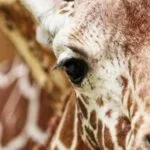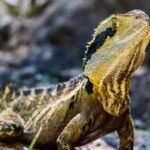“To Sleep, Perchance to Dream” (of Good Animal Welfare)
After recently attending a lecture discussing nocturnal behaviour in giraffe, Wild Welfare’s Animal Welfare Field Manager, Sarah Bonser-Blake decided to take a deep-dive into the importance of sleep. Resting and sleeping behaviours can have a significant impact on the welfare experienced by captive wild animals so in our latest blog, Sarah shares some of her findings.
How did you sleep last night? Was it dependent on how comfortable your mattress and pillow was? Did you crawl into bed feeling exhausted after a busy and stimulating day or did you take a long time to drift off? Sleep is just as important to animal well-being as it is to humans, and there are many external factors which might influence the quality of rest an animal experiences, and therefore their welfare.
When we talk about sleep in animals, we firstly need to be aware that some species have very different sleep requirements from our own. The traditional 8 hours of solid sleeping which is suggested for humans is a very species-specific recommendation. Other animals have different needs. Research has found that captive giraffe can spend an average of just 2% of their night-time activities engaged in REM sleep. In comparison to that, a species of bat has been recorded sleeping for 20 hours a day which is an energy saving strategy. Sadly, as much as there has been plenty of research conducted into mammalian sleep, there is still a lot to discover regarding the resting requirements of reptiles and amphibians.
Polyphasic sleep, where individuals take lots of power naps is quite a common strategy amongst the animal kingdom due to the need to be aware of potential predators. A study conducted on wild sloths found that a preference for sleeping during the night or the day was influenced by the perceived risk of predators within an environment. However, in social species, where there are more pairs of vigilant eyes keeping watch, some animals such as marmosets are able to enjoy monophasic sleep which is one long bought of sleep more similar to our own resting habits.
Lighting is another critical element which will impact the way an animal will experience their world, as well as their sleeping patterns. The daily cycle of lighting will create biological changes in an animal’s physiology, therefore artificial lights need to mimic circadian rhythms. This is to ensure that the individual will undertake natural behaviours associated with particular times of the day. For example, a crepuscular animal who is most active at dusk and dawn will need to have these time periods reflected in their lighting cycles in order to feel happy and healthy. The intensity of light is a further consideration given that an animal’s perception of light differs from species to species. The Zoological Lighting Institute is a partner of Wild Welfare’s who specialises in the science related to the specifics of lighting.

Image by kind permission of Adam Spencer
When it comes to caring for wild animals in captivity, what we offer for an animal to lie on or hide under can have a massive impact on their resting behaviours. If an animal feels comfortable, safe and secure in their environment then they are much more likely to get a decent level of sleep or rest. Cosy beds of straw, continuous access to indoor areas and being given a sense of privacy can all encourage healthy resting behaviours in captive wild animals.
In 2017, a ground-breaking study was published on Asian Elephants in Dublin Zoo which looked specifically into the sleeping habits of a herd of Asian Elephants and taught us a lot about their preferences, as well as night-time behaviours. The study highlighted the clear and obvious preference which the elephants had for their sleeping sites. When offered the option to sleep on a soft sand substrate or a concrete floor, the sand was chosen every single time. This study also found that there was a relationship between the age of the elephant and the amount of time they were sleeping, with young calves needing an average of five hours per night whilst older individuals needed only three and a half hours. In another study on elephant sleep, the potential for disturbances through noise pollution was also highlighted, which could lead to immunosuppression and subsequent illness. Noises from construction work, visitor activities and other environmental factors could all have an impact on resting patterns and animal health.
During Wild Welfare’s ten years of operation, we have worked hard to ensure that captive animals in facilities across the globe can experience a better standard of sleep. For example, a group of tigers in a facility in Thailand now have a range of platform beds to lounge around on due to the environmental enrichment training exercises we undertook as part of our Partner for Animals Project. Back in 2018, a group of Japanese bears who had been living on concrete for their entire lives got to experience the joys of a comfortable straw bed when we facilitated their rehoming to another facility. As part of our welfare auditor training, we always include the question of whether a facility provides comfortable and suitable resting places away from public view such as a den, burrow, nest, or other refuge area. This question emphasizes the importance of these kinds of spaces for animals, and how critical resting and sleep behaviours are for animal welfare.
platform beds to lounge around on due to the environmental enrichment training exercises we undertook as part of our Partner for Animals Project. Back in 2018, a group of Japanese bears who had been living on concrete for their entire lives got to experience the joys of a comfortable straw bed when we facilitated their rehoming to another facility. As part of our welfare auditor training, we always include the question of whether a facility provides comfortable and suitable resting places away from public view such as a den, burrow, nest, or other refuge area. This question emphasizes the importance of these kinds of spaces for animals, and how critical resting and sleep behaviours are for animal welfare.
For animals under human care, the opportunities for sleeping and resting behaviours are critical to ensure a good level of welfare. After animal care staff leave a facility for the night, the animals welfare needs still have to be met, therefore the more we know about a species’ sleeping habits, the more we can influence them positively whatever time of day or night.
Further information:
Biological and environmental factors as sources of variation in nocturnal behaviour of giraffe – https://onlinelibrary.wiley.com/doi/full/10.1002/zoo.21596
Ecology and Neurophysiology of Sleep in Two Wild Sloth Species – https://academic.oup.com/sleep/article/37/4/753/2416926
Sleep in Asian elephants (Elephas maximus): long-term quantitative research at Dublin Zoo – https://www.jzar.org/jzar/article/view/174/207
Social and environmental impacts on sleep in captive Asian elephants (Elephas maximus) – https://onlinelibrary.wiley.com/doi/abs/10.1002/zoo.21568
How Do Animals Sleep? – https://www.sleepfoundation.org/animals-and-sleep
Species Spotlight: Little brown bat – https://www.mass.gov/news/species-spotlight-little-brown-bat
The ecology of sleep in non-avian reptiles – https://onlinelibrary.wiley.com/doi/10.1111/brv.12808
Is there REM sleep in reptiles? A key question, but still unanswered – https://www.sciencedirect.com/science/article/abs/pii/S2468867320300018
The copyright of this content belongs to the author and any liability with regards to infringement of intellectual property rights remains with them.





